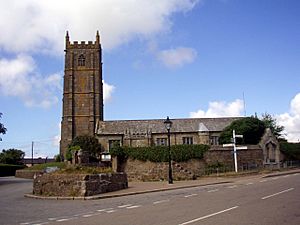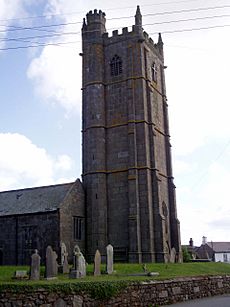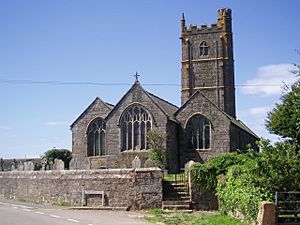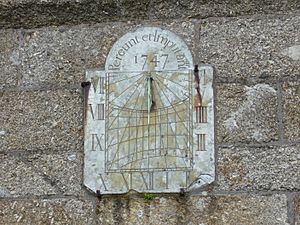St Buryan's Church facts for kids
Quick facts for kids St Buryan's Church, St Buryan |
|
|---|---|

St Buryan's Church
|
|
| Denomination | Church of England |
| Churchmanship | Broad Church |
| History | |
| Dedication | St Buryan |
| Administration | |
| Parish | St Buryan |
| Diocese | Truro |
| Province | Canterbury |
The Church of St Buryan is a historic Church of England parish church in the village of St Buryan, Cornwall. A parish is a local church community. Most of the building you see today was built in the late 1400s and early 1500s.
Contents
History of the Church
A King's Promise
A church has been on this spot since about the year 930. The story begins with King Athelstan, a famous Anglo-Saxon king. While on his way to conquer the Scilly Isles, he stopped at a small chapel dedicated to Saint Buriana to pray.
King Athelstan promised that if he won his battles, he would build a grander church on that very spot. He was successful, and true to his word, he founded a church and a small monastery for a group of clergy (church leaders). This made St Buryan one of the first monasteries in Cornwall.
Rebuilding and Restoring
The church was made bigger and rededicated to Saint Buriana in 1238. But by 1473, the building was in bad shape and needed major repairs. Large parts of it were rebuilt.
The current tower was finished in 1501. It stands 92 feet (28 meters) tall and is made of strong granite from the nearby Lamorna quarry. This same type of granite was later used to build the old London Bridge. The tower has a special turret on one corner with a spiral staircase inside.
Most of the main church building was constructed in the late 15th and 16th centuries. Over the years, it has been restored several times to keep it in good condition. In 1956, a new part called the Lady Chapel was added. Today, the church is protected as a Grade I listed building, meaning it is a very important historic site.
A Special Royal Church
Because King Athelstan founded it, the church of St Buryan had a special status. For a long time, it was known as a Royal Peculiar. This meant it was under the direct control of the King or Queen of England, not the local bishop. It was like its own little church district, or 'diocese'.
This caused a lot of arguments between the English Crown and the Bishops of Exeter for over 170 years. The bishops felt they had no power in St Buryan. They told the king they were afraid to go there, fearing they might be attacked.
The arguments got so bad that in 1327, a fight broke out in the churchyard. The next year, the Bishop excommunicated St Buryan, which meant it was officially cut off from the wider Church. It was not allowed back until 1336. Because of all these problems, the church building became very run down by 1473.
Eventually, the special status ended, and the church became part of the regular church system.
The Famous Church Bells
The church tower holds six large bells. Together, they are famous for being the heaviest set of six bells in the entire world. The set includes the world's third-heaviest treble bell (the highest-pitched bell in the set).
History of the Bells
The tower was first designed to hold eight bells. An order was placed in 1638, but it seems the full set was never made. By the late 1800s, only three bells were left.
In 1901, a bell foundry (a company that makes bells) recast two of the old bells and added a new, very large tenor bell (the lowest-pitched bell). However, the bells were not used much for many years.
Between 1990 and 2001, a man named Chris Venn led a project to restore them. The project raised £80,000, with help from people across the country, including Norma Major, the wife of the Prime Minister at the time, John Major. Two new bells were made at the famous Whitechapel Bell Foundry in London. This brought the total to six, and now a team of local ringers rings them regularly.
| weight | dia. | note | founder | inscription | |
|---|---|---|---|---|---|
| (cwts, qtrs, lbs) | (inches) | ||||
| Treble | 9-1-11 | 36 | A# | 2001 Whitechapel | I Ring Out Gods Love And Lead The Mighty Five And Rest With Solomon By My Side |
| 2 | 8-1-0 | 38 | G# | 1681 R Pennington | Mr Richard Davis Sampson Hutchins Wardens |
| 3 | 13-2-10 | 43 | F# | 1992 Whitechapel | Vocem ego do vobis date verba deo (I give my voice to you: give ye your words to God). Donated by Venn Bros Ltd (Cornwall) In memory of Eva Venn |
| 4 | 13-3-1 | 45 | E# | 1901 J Warner | Virginis egregiae vocor campana Mariae (I am called the bell of Mary the Glorious virgin) |
| 5 | 20-2-2 | 50 | D# | 1901 J Warner | Richard James Martyn Rector This bell was given to commemorate the Accession of King Edward VII AD 1901 by James Hawke Dennis, Benefactor to St Buryan Church |
| Tenor | 37-2-9 | 59 | C# | 1994 Whitechapel | ST SOLOMON Calcar sit quo deus laudetur vox mea (Let my voice be the spur with which to praise God). PRAY FOR US: Christopher J Venn (Tower Captain and Restorer); Joan Thomas; Revd Dr R Legg; B S Cheek; Christine Jago; K Gilbert; Helen Gilbert; J Ellis; Sarah Veal. In Fond Memory of T W Trevor Hitchens 30.12.24 - 23.12.92. Part cost of this bell was met by T Neil & Jane M Hitchens |
Organ and Churchyard
The church has a large pipe organ that was built in 1895.
The churchyard contains several ancient stone crosses. One expert in 1896 recorded twelve crosses in the St Buryan area, with one located in the churchyard itself.
A famous person buried here is Augustus Smith. He lived from 1804 to 1872 and was the first Lord Proprietor, or ruler, of the nearby Isles of Scilly.





